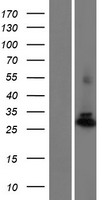PGAM4 (NM_001029891) Human Tagged ORF Clone
CAT#: RC213480
PGAM4 (Myc-DDK-tagged)-Human phosphoglycerate mutase family member 4 (PGAM4)
ORF Plasmid: tGFP
"NM_001029891" in other vectors (4)
Need custom modification / cloning service?
Get a free quote
CNY 2,400.00
CNY 3,705.00
CNY 300.00
CNY 1,999.00
CNY 2,700.00
Specifications
| Product Data | |
| Type | Human Tagged ORF Clone |
| Tag | Myc-DDK |
| Synonyms | dJ1000K24.1; PGAM-B; PGAM1; PGAM3 |
| Vector | pCMV6-Entry |
| E. coli Selection | Kanamycin (25 ug/mL) |
| Mammalian Cell Selection | Neomycin |
| Sequence Data |
>RC213480 representing NM_001029891
Red=Cloning site Blue=ORF Green=Tags(s) TTTTGTAATACGACTCACTATAGGGCGGCCGGGAATTCGTCGACTGGATCCGGTACCGAGGAGATCTGCC GCCGCGATCGCC ATGGCCGCCTACAAACTGGTGCTGATCCGGCACGGCGAGAGCACATGGAACCTGGAGAACCGCTTCAGCT GCTGGTACGACGCCGATCTGAGCCCGGCGGGCCACGAGGAGGCGAAGCGCGGCGGGCAGGCGCTACGAGA TGCTGGCTATGAGTTTGACATCTGCCTCACCTCAGTGCAGAAGAGAGTGATCCGGACCCTCTGGACAGTG CTAGATGCCATTGATCAGATGTGGCTGCCAGTGGTGAGGACTTGGCGCCTCAATGAGCGGCACTATGGGG GTCTAACCGGTCTCAATAAAGCAGAAACTGCTGCAAAGCATGGTGAGGCCCAGGTGAAGATCTGGAGGCG CTCCTATGATGTCCCACCACCTCCGATGGAGCCCGACCATCCTTTCTACAGCAACATCAGTAAGGATCGC AGGTATGCAGACCTCACAGAAGATCAGCTACCCTCCTATGAGAGTCCGAAGGATACTATTGCCAGAGCTC TGCCCTTCTGGAATGAAGAAATAGTTCCCCAGATCAAGGAGGGGAAACGTGTACTGATTGCAGCCCATGG CAACAGCCTCCAGGGCATTGCCAAGCATGTGGAGGGTCTCTCTGAAGAGGCTATCATGGAGCTGAACCTG CCGACTGGTATTCCCATCGTCTATGAATTGGACAAGAACTTGAAGCCTATCAAGCCCATGCAGTTTCTGG GGGATGAAGAGACGGTGTGCAAAGCCATAGAAGCTGTGGCTGCCCAGGGCAAGGCCAAGAAG ACGCGTACGCGGCCGCTCGAGCAGAAACTCATCTCAGAAGAGGATCTGGCAGCAAATGATATCCTGGATT ACAAGGATGACGACGATAAGGTTTAA >RC213480 representing NM_001029891
Red=Cloning site Green=Tags(s) MAAYKLVLIRHGESTWNLENRFSCWYDADLSPAGHEEAKRGGQALRDAGYEFDICLTSVQKRVIRTLWTV LDAIDQMWLPVVRTWRLNERHYGGLTGLNKAETAAKHGEAQVKIWRRSYDVPPPPMEPDHPFYSNISKDR RYADLTEDQLPSYESPKDTIARALPFWNEEIVPQIKEGKRVLIAAHGNSLQGIAKHVEGLSEEAIMELNL PTGIPIVYELDKNLKPIKPMQFLGDEETVCKAIEAVAAQGKAKK TRTRPLEQKLISEEDLAANDILDYKDDDDKV |
| Chromatograms |
CHROMATOGRAMS
 Sequencher program is needed, download here. |
| Restriction Sites |
SgfI-MluI
Cloning Scheme for this gene
Plasmid Map

|
| ACCN | NM_001029891 |
| ORF Size | 762 bp |
| OTI Disclaimer | The molecular sequence of this clone aligns with the gene accession number as a point of reference only. However, individual transcript sequences of the same gene can differ through naturally occurring variations (e.g. polymorphisms), each with its own valid existence. This clone is substantially in agreement with the reference, but a complete review of all prevailing variants is recommended prior to use. More info |
| OTI Annotation | This clone was engineered to express the complete ORF with an expression tag. Expression varies depending on the nature of the gene. |
| Product Components | The ORF clone is ion-exchange column purified and shipped in a 2D barcoded Matrix tube containing 10ug of transfection-ready, dried plasmid DNA (reconstitute with 100 ul of water). |
| Reconstitution | 1. Centrifuge at 5,000xg for 5min. 2. Carefully open the tube and add 100ul of sterile water to dissolve the DNA. 3. Close the tube and incubate for 10 minutes at room temperature. 4. Briefly vortex the tube and then do a quick spin (less than 5000xg) to concentrate the liquid at the bottom. 5. Store the suspended plasmid at -20°C. The DNA is stable for at least one year from date of shipping when stored at -20°C. |
| Reference Data | |
| RefSeq | NM_001029891.3 |
| RefSeq Size | 1678 bp |
| RefSeq ORF | 765 bp |
| Locus ID | 441531 |
| UniProt ID | Q8N0Y7 |
| Protein Pathways | Glycolysis / Gluconeogenesis, Metabolic pathways |
| MW | 28.6 kDa |
| Gene Summary | This intronless gene appears to have arisen from a retrotransposition event, yet it is thought to be an expressed, protein-coding gene. The encoded protein is a member of the phosphoglycerate mutase family, a set of enzymes that catalyze the transfer of a phosphate group from 3-phosphoglycerate to 2-phosphoglycerate. [provided by RefSeq, May 2010] |
Documents
| Product Manuals |
| FAQs |
| SDS |
Resources
Other Versions
| SKU | Description | Size | Price |
|---|---|---|---|
| RC213480L3 | Lenti ORF clone of Human phosphoglycerate mutase family member 4 (PGAM4), Myc-DDK-tagged |
CNY 5,890.00 |
|
| RC213480L4 | Lenti ORF clone of Human phosphoglycerate mutase family member 4 (PGAM4), mGFP tagged |
CNY 5,890.00 |
|
| RG213480 | PGAM4 (tGFP-tagged) - Human phosphoglycerate mutase family member 4 (PGAM4) |
CNY 4,370.00 |
|
| SC302465 | PGAM4 (untagged)-Human phosphoglycerate mutase family member 4 (PGAM4) |
CNY 3,990.00 |


 United States
United States
 Germany
Germany
 Japan
Japan
 United Kingdom
United Kingdom
 China
China




